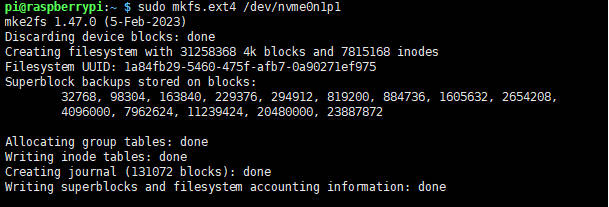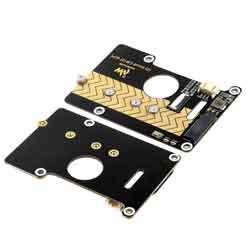- sales/support
Google Chat: zj734465502@gmail.com
- sales
+86-0755-88291180
- sales01
sales@spotpear.com
- sales02
dragon_manager@163.com
- support
tech-support@spotpear.com
- CEO-Complaints
zhoujie@spotpear.com
- sales/support
WhatsApp:13246739196
PCIe-TO-M.2-Board-(D) User Guide
Overview
This PCIe TO M.2 M key board is designed for Raspberry Pi 5, compatible with 2230/2242/2260/2280 size M.2 solid state drive, supports Gen2 and Gen3 modes, supports booting PI5 from solid state drive (SSD).
Features
- Support NVMe protocol M.2 interface solid state drive protocol, high-speed write/read, higher working efficiency.
- Support PCI-E×1 Gen2 or Gen3 mode.
- Only support PI5B.
- Compatible with 2230/2242/2260/2280 size M.2 solid state drive.
- Onboard working indicator, light-up when powering on, and the ACT status indicator keeps blinking while writing/reading.
Note
- As Raspberry Pi does not support booting from NVME by default, you need to modify it to realize it.
User Guide
Hardware Connection
Please pay attention to the wiring direction, as shown below:
Mount
1: Enable PCIE interface:
PCIE interface is not enabled on the Raspberry Pi 5 by default, you can add the following content to enable it at /boot/firmware/config.txt: dtparam=pciex1
2: PCIE gen2 is the default setting, if you want to enable PCIE gen3, you need to add the following content at /boot/firmware/config.txt:
dtparam=pciex1_gen=3
3: Reboot PI5 after modification, and the device can be recognized.
In the picture below, the SM2263 is recognized as my SSD solid state, and the other PI5 one is the RPI chip.
4: Partitioning: If partitioning and formatting have already been performed on another platform, skip this step. Note: Partitioning and formatting will erase all data on the SSD, so please carefully perform this step.
lsblk #see the disk (execute "sudo fdisk -l" for more details)Partition sudo fdisk /dev/nvme0n1 #dev is the total device number, do not add "p1", it is just one partition How do use fdisk n New partition q Exit without saving p Print partition table m Print selection menu d Delete partition w Save and exit t Modify ID Add the partition and execute "n", and then press "w" to save and exit.
5: Format.
sudo mkfs. #Then, pressing Tab will display various file extensions. Each extension corresponds to a format you may want to format the drive into If I need to format it in "ext4" format, execute: sudo mkfs.ext4 /dev/nvme0n1p1 Wait for a moment, when "done" appears for all, it means the formatting is complete.
6: Mount.
Create the mounting directory: sudo mkdir toshiba Mount the device sudo mount /dev/nvme0n1p1 ./toshiba Check disk status df -h
Read/Write Test
Enter the directory to mount the disk.
cd toshiba
- Release the caches.
sudo sh -c "sync && echo 3 > /proc/sys/vm/drop_caches"
- Copy the Raspberry Pi memory to the hard flash driver (write).
sudo dd if=/dev/zero of=./test_write count=2000 bs=1024k
- Copy the contents of the hard drive to the Raspberry Pi's memory (/etc/fstab read).
sudo dd if=./test_write of=/dev/null count=2000 bs=1024k
- Note: Different cards and environments may produce different effects on the Raspberry Pi's performance, so for accurate performance testing, it's recommended to use a PC.
Auto Mount
If there are no issues with the test and the disk is not needed as a system disk, only for expanding disk usage, set up automatic mounting.
sudo nano /etc/fstab #Add the following content at the end: /dev/nvme0n1p1 /home/pi/toshiba ext4 defaults 0 0 #/dev/nvme0n1p1 device name, /home/pi/toshiba mount to the directory, ext4 is the file system type, defaults means using the default mounting options #Reboot to take effect (Please make sure there are no issues before rebooting, otherwise it can not be booted without mounting) sudo mount -a #And then reboot Check the device through lsblk
NVMe SSD Booting
Start the Raspberry Pi using the SD card, mount, and test to ensure that the hardware is functioning properly.
We provide two methods for you, you can select one to operate:
Method 1
1: Execute:
sudo raspi-config

2: Reboot the Raspberry Pi:
If you find that you can't modify the file several times, please connect to the network and modify it again (wait for the network time synchronization), or set the correct time before modifying the file.
3: Flash the system into NVME, then connect the NVME to the expansion board, remove the SD card and re-power on.
Method 2
1: Start the Raspberry Pi using the SD card and modify the BOOT_ORDER in the Raspberry Pi's bootloader configuration.
sudo rpi-eeprom-config --edit Modify BOOT_ORDER=0xf41 as BOOT_ORDER=0xf416For details, please refer to BOOT_ORDER
2: Reboot the Raspberry Pi:
If you find that you can't modify the file several times, please connect to the network before modifying the file (wait for the network to time itself), or set the correct time before modifying the file.
3: Just program the system into NVME, then connect it to the expansion board, remove the SD card, and re-power it up.
Support
Monday-Friday (9:30-6:30) Saturday (9:30-5:30)
Mobile: +86 13434470212
Email: services01@spotpear.com




